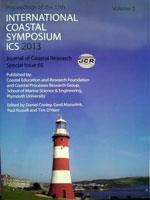Bryan, K.R. Foster, R., and MacDonald, I. 2013., Beach Rotation at Two Adjacent Headland-Enclosed Beaches
Shoreline rotation occurs on headland-enclosed beaches when the wave climate causes sand to accumulate preferentially on one end of the beach. Past research has shown that these rotation events can occur in response to seasonal variations in the wave climate. Here we investigate 3 years of shoreline variations on two adjacent beaches in New Zealand that are exposed to the same wave climate and tidal conditions, but with different morphodynamic classification. Tairua Beach is approximately 1.2 km long, and is composed of medium-fine sand. Pauanui Beach is approximately 3 km long, and is characterised by lower slopes and finer sand grain sizes. The textural differences are caused by the proximity of Pauanui Beach to the entrance of Tairua Estuary. Both beaches are overlooked by video monitoring stations which collect 15-minute averages of video footage every hour between 2002 and 2004. Shorelines were detected by using the ratio of red to blue light to identify the water-sand boundary. Rotation was quantified by fitting a regression line to the alongshore series of shoreline locations. Results showed that both beaches accreted and eroded by comparable amounts during storm events. However, the rotation characteristics were quite different, with the magnitude of rotation being far greater at the shorter Tairua Beach than at Pauanui. Pauanui responded with a slow rotation over the whole dataset rather than the more event-based rotation that occurred at Tairua Beach. In addition, the two beaches rotated in opposite directions during most of the dataset. A SWAN model was set up to understand the wave induced processes that caused the differences in rotation between the two sites. The model grid was generated from a multibeam survey of the site. The model was set up in a stationary mode providing a solution every 3 hours over the entire duration of the dataset. Results showed that the alongshore wave energy flux was largely controlled by the presence of two offshore islands, Shoe and Slipper island, which caused shadowing of the north end of Pauanui Beach and the south end of Tairua Beach. This in turn accounts for the observed differences in the rotation pattern at the two beaches. These results show that the offshore topography was a stronger control on rotation than overall changes to the alongshore wave energy flux driven by incidence angle changes alone.





